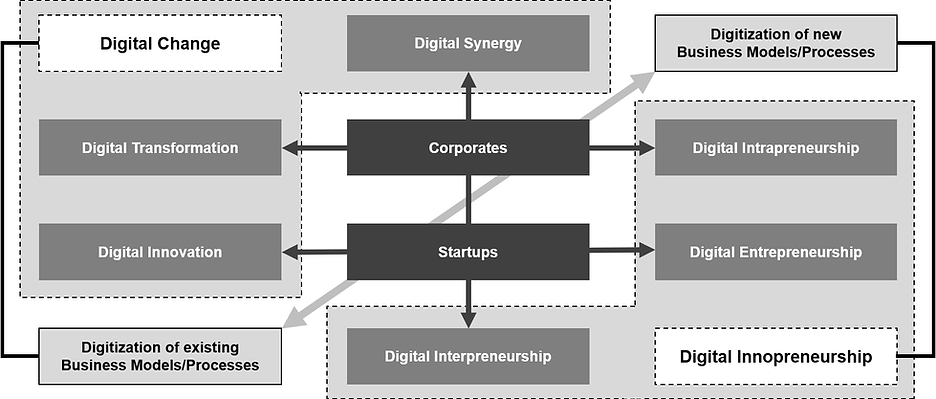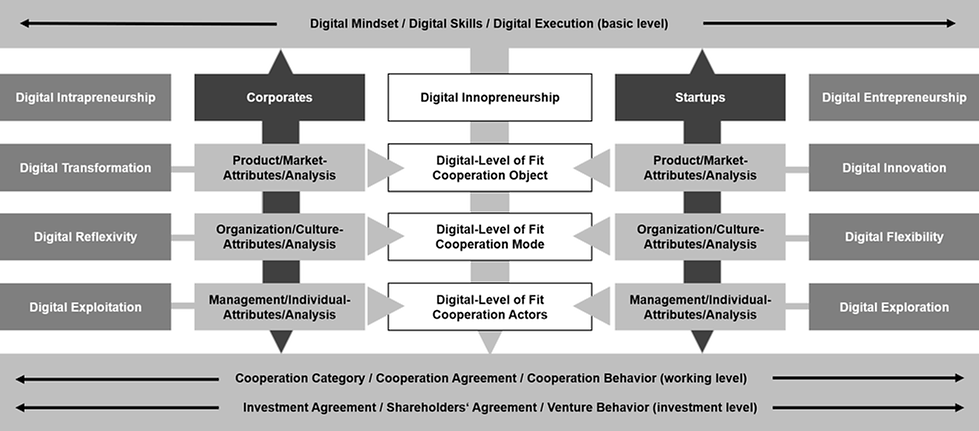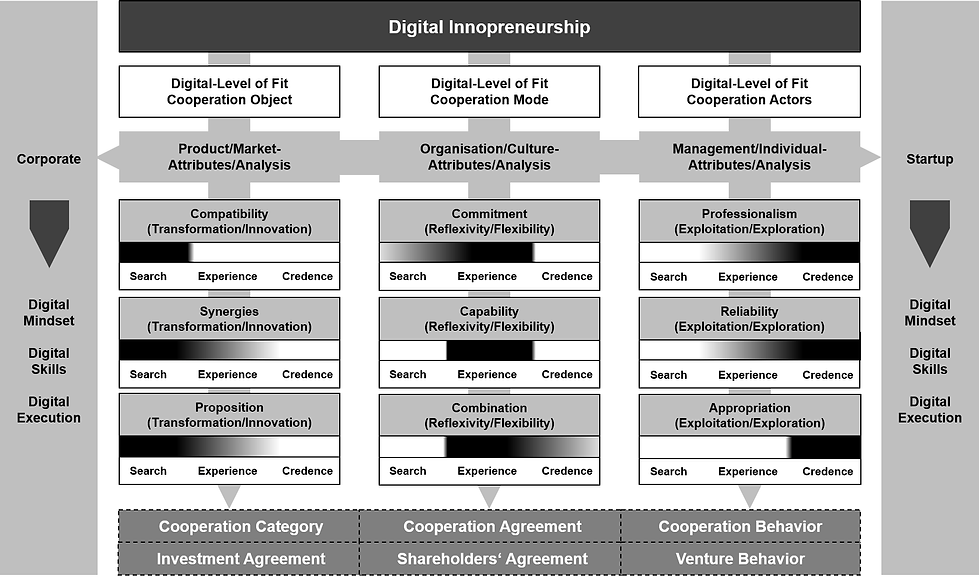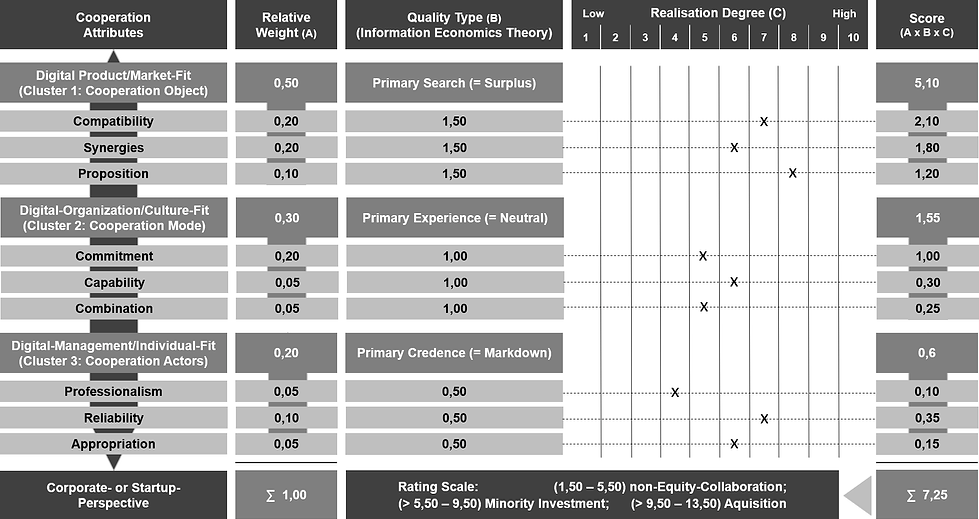
Digital Innopreneurship
Basics of Collaboration between Corporates and Startups in the Digital Economy
"Digital Innopreneurship" refers to the creation of a Digital-Innovation-Capability of the players involved from startups, SMEs and corporates, which is made up of the Digital-Transformation-Strength (Digital Intrapreneurship), the Digital-Innovation-Strength (Digital Entrepreneurship) and the Digital-Synergy-Strength (Digital Interpreneurship) of these players.
Digital Innopreneurship
The individual measures under which Digital Innopreneurship is considered in the respective sectors are initially of secondary importance. Rather, this is an umbrella term that addresses all activities for the Digital-Innovation-Capability of the actors involved at the various levels. The more or less familiar disciplines of Intrapreneurship, Entrepreneurship and Interpreneurship are combined in the nucleus of digitalisation to form an overall discipline for the Digital-Innovation-Capability of an economy as an umbrella term. Various axes are considered in connection with the actors involved (see Figure below). Firstly, the axis of a "Digital Transformation" with the sub-categories of a "Digital Transformation" for corporates, SMEs and industry, a "digital innovation" with reference to startups and a "digital synergy" with cooperation between startups, SMEs and industry. The resulting "digitalisation of old business models/processes" requires the digitalisation, modernisation or automation of business models and processes that already exist on the basis of an associated Digital-Innovation- Capability. This Digital-Innovation-Capability also determines the second axis in which this capability requires "Digital Intrapreneurship" from the perspective of corporates, SMEs and industry, while startups address "Digital Entrepreneurship" for this purpose. The bringing together of both groups with regard to the formation of a joint Digital-Innovation-Capability is motivated by "Digital Interpreneurship". All three areas together result or are formed by "Digital Innopreneurship", which in turn describes the entire Digital-Innovation-Capability as a Digital Transformation, innovation and synergy force for the individual players and overall as an economic group with regard to the "digitalisation of new business models/processes" (see Figure below).

The Basics of
Digital
Innopreneurship
Tobias Kollmann • Niklas Kollmann
Full Titel
Digital Innopreneurship 1: The Basics of Collaboration Between Corporates and Startups in the Digital Economy
Journal
Science Journal of Business and Management
DOI
10.11648/j.sjbm.20251302.17
Publication Date
2025-20-06
The article is available online here: https://doi.org/10.11648/j.sjbm.20251302.17
or as a PDF here: https://www.sciencepg.com/article/10.11648/j.sjbm.20251302.17

Abstract
From an overall perspective, digitalisation is generally determined by two main trends: Firstly, digital innovations, which are usually developed and brought to market by small startups in the form of new digital technologies or new digital business processes and models. The second is Digital Transformation, which usually involves large corporates digitising their existing technologies or existing business processes and models (although this can also be done innovatively). The question now, however, is how these two trends can be combined to create a new force for digital progress that would benefit both startups and corporates from a macroeconomic perspective. In this respect, the term "Digital Innopreneurship" describes the creation of a joint Digital-Innovation-Capability and Digital-Transformation-Capability of startups and corporates, which is made up of the Digital-Innovation-Strength of startups (Digital Entrepreneurship), the Digital-Transformation-Strength of corporates (Digital Intrapreneurship) and the Digital-Synergy-Strength (Digital Interpreneurship) between these two players. This article (Part 1) is intended to illustrate this and describe the potential for cooperation, while the following article (Part 2) will focus on the evaluation of cooperation.
https://www.sciencepg.com/article/10.11648/j.sjbm.20251302.17
Background
Digitalisation is one of the most important economic issues worldwide. The drivers of digitalization are, on the one hand, the digital transformation of existing business models of established companies in traditional industry and SMEs and, on the other hand, digital innovation for new business models, which is very often driven by young companies (start-ups). Against this background, the following questions arise in particular: How can established corporates master the task of Digital Transformation in order to secure their competitiveness in the area of digitalisation? How can new startups be created that develop digital innovations and thus contribute to economic growth in the future? How can and should established corporations and young startups cooperate to build joint competitiveness in the digital economy? Against this background, startups, as well as SMEs and corporates, stand side by side and can address the associated goals of a Digital Transformation and Digital Innovation of the economy. The different paths of Digital Intrapreneurship, Digital Entrepreneurship and Digital Interpreneurship point to a new nucleus when combined: Digital Innopreneurship!
https://www.sciencepg.com/article/10.11648/j.sjbm.20251302.17
Framework for Digital Innopreneurship
In order to enable successful Digital Innopreneurship, these framework conditions should/must be examined from both sides in advance of a collaboration between a corporate and a startup. The result (see Figure below) is the consideration of a triad of Cooperation Object, Cooperation Mode and Cooperation Actors for Digital Innopreneurship (see Figure below). This triad for an associated test model refers accordingly to the selection of suitable attributes and associated analysis of a digital product/market fit (cluster 1: Cooperation Object), a digital organisational/cultural fit (cluster 2: Cooperation Mode) and a digital management/individual fit (cluster 3: Cooperation Actors) from the respective perspective of the corporate and startup that want to enter into associated cooperation. Accordingly, the two perspectives should be analysed both separately and together.
https://www.sciencepg.com/article/10.11648/j.sjbm.20251302.17

Source: Kollmann, T., Kollmann, N. (2025). Digital Innopreneurship 1: The Basics of Collaboration Between Corporates and Startups in the Digital Economy. Science Journal of Business and Management, 13(2), 118-134.
https://www.sciencepg.com/article/10.11648/j.sjbm.20251302.17
Digital Intrapreneurship
The aim of “Digital Intrapreneurship” is to support an organisation's existing employees in developing and scaling their own digital ideas [45, 46]. The term was first mentioned by Gifford Pinchot [47], who defined intrapreneurs in general terms as dreamers who take action and assume responsibility for developing innovations of all kinds within companies. Intrapreneurship as a bottom-up approach, therefore, focuses on the employees themselves as creative individuals who want to develop new ideas and thus also their company and drive innovation [48]. Intrapreneurs operate at the edges of the organisation in order to expand existing products, services and technologies and thus increase diversification, develop new company potential and promote disruption [49, 50].
Against this backdrop, the Digital Transformation of an economy presents existing companies with particular challenges in terms of Digital Transformation, which is why Digital Intrapreneurship is an essential measure for utilising creativity, diversity and disruption within the company as a basis for digital innovations. Against this backdrop, Digital Intrapreneurship can be defined as follows [26], p. 21:
"Digital Intrapreneurship" describes both the innovative use of digital technologies to adapt and expand existing business models and processes to digital competition and the derivative or independent development of new digital innovations as the basis for future digital business models and processes by entrepreneurial employees for the benefit of their employer.
https://www.sciencepg.com/article/10.11648/j.sjbm.20251302.17
Digital Entrepreneurship
As part of Digital Entrepreneurship, "founders should establish a new and independent company (so-called startup) on the basis of an innovative digital idea" [26], p. 21. Startups in this field play an outstanding role in the social and economic development of a country. The background to this is the fact that every startup creates a new market participant that has a stimulating effect on digital competition and thus further drives economic dynamism [26].
The Digital Transformation of an economy represents a special opportunity for new companies in the context of Digital Transformation, which is why Digital Entrepreneurship is an essential measure for utilising creativity, diversity and disruption for digital innovations as a basis for setting up a company [28, 72]. As early as 2006, Kollmann [73], p. 333 speaks of "establishing a new company with an innovative business idea within the net [digital] economy, which, using an electronic [digital] platform in data networks, offers its products and/or services based upon a purely electronic [digital] creation of value. Essential is the fact that this value offer was only made possible through the development of information technology." Against this background, Digital Entrepreneurship can be defined as follows [26], p. 25:
"Digital Entrepreneurship is understood to mean the creation of an independent and original legal business entity in the digital economy (digital venture) within which the independent founder(s) wants to meet a third-party need with a specific online offering (product or service)."
https://www.sciencepg.com/article/10.11648/j.sjbm.20251302.17
Digital Interpreneurship
Within the framework of Digital Interpreneurship, startups, SMEs, and the industry should work together with a view to joint Digital-Innovation-Capability [74, 75]. A startup and an established company are two organisational forms that could not be more different at first glance [53] - especially with regard to Digital Transformation. Startups often focus their business models on the novel utilisation of digital information [26]. With their innovative strength, agility, willingness to take risks and strive for growth, they want to make the best possible use of the advantages of digital technologies [76].
At the same time, established companies - i.e. companies that are more than ten years old, have already reached a certain size and have established themselves in at least one mar ket segment - are under increasing pressure to implement ad vanced digital technologies in order to innovate and transform existing business models, despite their supposed strengths (such as financial resources and experience, [80]). Against this background, Digital Interpreneurship can be defined as follows [26], p. 29:
"Digital Interpreneurship" describes the cooperation/col la boration of existing companies (corporates/SMEs/family businesses) with new companies (startups) with regard to digital innovations for the derivative or dependent adaptation and expansion of existing or the development of ori ginal or independent and thus new digital business models and processes for digital competition through the mutual contribution of complementary resources.
https://www.sciencepg.com/article/10.11648/j.sjbm.20251302.17
The Nucleus: Digital Innopreneurship
According to the Competence Centre for Innovation and Entrepreneurship at the University of Duisburg-Essen, the acronym "Innopreneurship" - usually interpreted as a combination of innovation and entrepreneurship - describes the goal of promoting innovative entrepreneurship, outlining projects that open up new markets and value chains [92]. In the interpretation of this article, the definition of the term goes beyond this and is also more differentiated according to the various sources of an associated innovative capacity, especially for the area of digitalisation as the basis for the development of associated new digital business models and processes. Here, startups, SMEs and industry are added as the key players and their objectives with regard to innovation development specifically for Digital Transformation. Accordingly, the term "Digital Innopreneurship" can be described as follows:
The term "Digital Innopreneurship" refers to the creation of a Digital-Innovation-Capability of the players involved from startups, SMEs and corporates, which is made up of the Digital-Transformation-Strength (Digital Intrapreneurship), the Digital-Innovation-Strength (Digital Entrepreneurship) and the Digital-Synergy-Strength (Digital Interpreneurship) of these players.
Therefore, Digital Innopreneurship means adopting a new perspective and recognising, promoting and valuing entrepreneurial thinking among and for all stakeholders in individual and joint digital projects. This relates not only to the digital technologies themselves but also to the associated development and application knowledge and the digital expertise to implement this knowledge in (new) digital business processes and models. This requires corporates, SMEs and family businesses that want to "reinvent themselves digitally" on the one hand and startups that have "reinvented themselves digitally" on the other. The focus is not only on the institutions but also on the people involved as innovators - that is an important point.
Based on the considerations so far, three areas in particular need to be examined more closely regarding the framework conditions for Digital Innopreneurship:
-
Digital-Innovation-Capability: What skills or characteristics must an actor have in order to develop digital innovations and do these differ with regard to the business environment in which they work (startups, SMEs, family businesses, corporates)?
-
Digital-Innovation-Development: Which digital business models and processes are developed by the actors involved based on their specific digital innovation skills in which area?
-
Digital-Innovation-Culture: What framework conditions must be created in the respective corporate environment so that the actors involved can develop their digital innovation capabilities?
https://www.sciencepg.com/article/10.11648/j.sjbm.20251302.17
Authors
Prof. Dr. Tobias Kollmann -> LinkedIn
Owner of the Chair of Digital Business and Digital Entrepreneurship, University of Duisburg-Essen, Universitaetsstr. 9, 45141 Essen, Germany tobias.kollmann [[at]] uni-due.de
Prof. Kollmann has been working on scientific issues related to the Internet, Digital Business and E-Commerce since 1996. His research results have been published in international A-Journals such as Entrepreneurship Theory and Practice (ETP), Journal of Business Venturing (JBV), Strategic Entrepreneurship Journal (SEJ) and Journal of Management Information Systems (JMIS). According to FAZ, he was among the 100 most influential Economists in Germany in 2018, 2019 and 2021 with "weight in media, research and politics."
Niklas Kollmann, M.Sc. -> LinkedIn
Faculty of Economics, Nova School of Business and Economics, Rua da Holanda, no. 1, 2775-405, Carcavelos, Portugal
Niklas Kollmann (M.Sc.) completed his bachelor's degree at the Ludwig-Maximilians-University of Munich (LMU) with a semester abroad at ESSEC Business School in Paris and his master´s degree at the Nova School of Business and Economics (Nova SBE) in Lisbon with a semester abroad at the University of Cape Town (UCT).
Open Access
Open Access
This article is licensed under a Creative Commons Attribution 4.0 International License, which permits use, sharing, adaptation, distribution and reproduction in any medium or format, as long as you give appropriate credit to the original author(s) and the source, provide a link to the Creative Commons licence, and indicate if changes were made.
The images or other third party material in this article are included in the article's Creative Commons licence, unless indicated otherwise in a credit line to the material. If material is not included in the article's Creative Commons licence and your intended use is not permitted by statutory regulation or exceeds the permitted use, you will need to obtain permission directly from the copyright holder.
To view a copy of this licence, visit
http://creativecommons.org/licenses/by/4.0/.
Cite the article
Kollmann, T., Kollmann, N. (2025). Digital Innopreneurship 1: The Basics of Collaboration Between Corporates and Startups in the Digital Economy. Science Journal of Business and Management, 13(2), 118-134. https://doi.org/10.11648/j.sjbm.20251302.17
The Evaluation of
Digital
Innopreneurship
Tobias Kollmann • Niklas Kollmann
Full Titel
Digital Innopreneurship 2: The Evaluation of Collaboration Between Corporates and Startups in the Digital Economy
Journal
Science Journal of Business and Management
DOI
10.11648/j.sjbm.20251302.18
Publication Date
2025-20-06
The article is available online here: https://doi.org/10.11648/j.sjbm.20251302.18
or as a PDF here: https://www.sciencepg.com/article/10.11648/j.sjbm.20251302.18

Abstract
According to the previous article (Part 1), the term "Digital Innopreneurship" describes the creation of a joint digital innovation and transformation capability of startups and corporates, which is made up of the digital innovation power of startups (Digital Entrepreneurship), the digital transformation power of corporates (Digital Intrapreneurship) and the digital synergy power (Digital Interpreneurship) between these two actors. In order to unleash this power, corporates and startups must work together to shape the Digital-Innovation-Capability, Digital-Innovation-Development and Digital-Innovation-Culture in a mutually beneficial way for both sides without disregarding their respective strengths and weaknesses. Against this backdrop, the players involved naturally ask themselves what such a collaboration could look like and what attributes both sides can use to check in advance whether they really fit together and which cooperation or participation model is most suitable. This article (Part 2) is intended to illustrate this conceptually and describe an initial possibility for evaluating such a cooperation between corporates and startups.
From an overall perspective, the previous article (Digital Innopreneurship - Part 1) has already established that the strengths and weaknesses of corporates and startups almost balance each other out regarding the common challenge of digital change and that cooperation in this area is almost obvious. This applies both to the micro-level of the players in volved in their companies and to the macro-level of the associated national economy in which they are located. Against this backdrop, the area of innovation-promoting cooperation between startups and established companies is receiving increasing attention ([15]: Digital Innopreneurship - Part 1).
https://www.sciencepg.com/article/10.11648/j.sjbm.20251302.18
Background
Both sides can, therefore, benefit from the associated cooperation (Digital Interpreneurship). The experience, entrepreneurial expertise, and industry knowledge of a corporation are advantages for a startup. Furthermore, the corporation can support a startup financially or with additional resources to promote its growth. Conversely, the corporate can access the startup's rapid development of digital innovations and integrate them into its own value creation for the (real) existing business as well as the (digital) innovation business as part of a cooperation. Both sides can/should thereby increase their digital transformation and innovation capabilities and, at best, jointly develop new business models in the digital economy. At the same time, the collaboration promotes the transfer of knowledge and technology in both directions, which also increases or should increase the (respective) competitiveness of both players.
If we now assume that a Corporate-Startup-Collaboration is advantageous in the context of a Digital Innopreneurship and if we can understand the associated framework conditions from the first part of this article (Digital Innopreneurship - Part 1), then the supplementary research questions that must first be answered conceptually for the evaluation of a collaboration between corporates and startups in or for a digital economy(s) now arise for the subsequent article: 1. What types/models of collaboration exist between corporates and startups and how can they be categorised? 2. Which attributes can be used to analyse cooperation between corporates and startups? 3. What can a decision model look like in which the evaluation of the selected attributes leads to a specific type/mo del for collaboration between corporates and startups?
https://www.sciencepg.com/article/10.11648/j.sjbm.20251302.18
Evaluation of Digital Innopreneurship
There are many references in the literature to attributes that influence cooperation between corporates and startups or the selection of a specific cooperation model. It is easy to see that these are generally formulated from the perspective of corporates. In contrast, there are hardly any considerations from the startup perspective. Whether this postulates that the large partner (corporate) has a choice while the small partner (startup) does not, especially at the beginning, remains to be seen. However, there is no evidence why the (most) criteria/attributes from the corporate perspective cannot/should not be used from the startup's perspective to select the right cooperation partner. Numerous practical examples show that startups also had the choice of which corporate they wanted to work with. For example, the partnership between OpenAI and Microsoft is one such case [16]: OpenAI chose Microsoft as a partner mainly due to the capacity of its cloud infrastructure to develop its language models further. Accordingly, we first want to assume that the attributes can play a reciprocal role for both corporates and startups, even if the literature cannot prove or disprove this. With this in mind, we first want to extract a relevant number from the many references to relevant attributes and categorise them for ease of use. This is initially limiting, but it is expedient with regard to the actual development of a decision model and the construction of an associated logic. As a result, a triad of cooperation object (cluster 1), cooperation mode (cluster 2) and cooperation actors (cluster 3) with the associated attributes is initially formed.
https://www.sciencepg.com/article/10.11648/j.sjbm.20251302.18

Source: Kollmann, T., Kollmann, N. (2025). Digital Innopreneurship 2: The Evaluation of Collaboration Between Corporates and Startups in the Digital Economy. Science Journal of Business and Management, 13(2), 135-154.
https://www.sciencepg.com/article/10.11648/j.sjbm.20251302.18
Cluster 1:
Digital-
Product/
Market-Fit
The attributes "Compatibility", "Synergies", and "Proposition" can be summarised in a cluster with an associated "Digital-Product/Market-Fit", as the attributes relate to decision features in which a mutual evaluation takes place for an expected strategic or operational advantage at the level of the "Cooperation Object" (product, process, platform, market, competition) under the influence of digital change.
In the overall analysis of the attributes for the "Digital-Product/Market-Fit", it can be stated that this cluster is primarily determined by search qualities and is supplemented secondarily by experience qualities (see Figure above).
https://www.sciencepg.com/article/10.11648/j.sjbm.20251302.18
Cluster 2:
Digital-Organizational/
Cultural-Fit
The attributes "Commitment", "Capability", and "Combination" can be combined into a cluster with an associated "Digital-Organisation/Culture-Fit", as the attributes refer to decision characteristics in which a mutual evaluation of an expected strategic or operational link takes place at the level of the "Cooperation Mode" (structure, standards, procedures, compliance) under the influence of digital change.
In the overall view of the attributes for the "Digital-Organisation/Culture-Fit", it can be stated that this cluster is primarily determined by experience qualities and is supplemented secondarily by search and credence qualities (see Figure above).
https://www.sciencepg.com/article/10.11648/j.sjbm.20251302.18
Cluster 3:
Digital-Management/
Individual-Fit
The attributes "Professionalism", "Reliability", and "Appropriation" can be combined into a cluster with an associated "Digital-Management/Individual-Fit", as the attributes refer to decision characteristics in which a mutual evaluation of expected strategic and operational behaviour takes place at the level of the "Cooperation Actors" (personality, character, motivation, values) under the influence of digital change.
In the overall view of the attributes for the "Digital-Manage ment/Individual-Fit", it can be stated that this cluster is primarily characterised by credence qualities and is supplemented secondarily by experience qualities (see Figure above).
https://www.sciencepg.com/article/10.11648/j.sjbm.20251302.18
Scoring-Model for Digital Innopreneurship
Now that the central attributes for evaluating a Corporate-Startup-Collaboration have been derived from the literature categorised into groups and moderated by the information-economic characteristics, a first associated evaluation and decision model will be presented. Since no causal-analysis or regression-based models exist in this context and the associated impact relationships between drivers, moderators and forms of cooperation have not yet been investigated, a simplified procedure must be used here. In connection with the evaluation of business ideas and product innovations, so-called scoring models have been used in many places in the literature to assess the realisation potential of an idea. Richman [99] laid the foundation for this by developing a scoring model to assess the compatibility of product innovations with existing internal resources. Weiber et al. [100] utilised this approach to evaluate the potential use of a product idea grounded in a company's resources potential. Kollmann [4], p. 196 ff., in turn, used the scoring model method to evaluate the realisation potential of a possible implementation of a digital business idea from a startup perspective. Therefore, the scoring model's core concept is also an obvious choice for evaluating the realisation potential of individual attributes and deriving a decision for a specific category of cooperation types/models based on this. The Figure (see below) outlines the initial considerations for a scoring model for selecting a suitable category of collaboration types/models in the context of a Corporate-Startup-Collaboration.
For full Explanation:
https://www.sciencepg.com/article/10.11648/j.sjbm.20251302.18

Source: Kollmann, T., Kollmann, N. (2025). Digital Innopreneurship 2: The Evaluation of Collaboration Between Corporates and Startups in the Digital Economy. Science Journal of Business and Management, 13(2), 135-154.
https://www.sciencepg.com/article/10.11648/j.sjbm.20251302.18
Conclusion
The presented "Framework for the Evaluation of a Corporate-Startup-Collaboration" with regard to a joint digital innovation capability opens up much potential for future research with regard to a theoretical, empirical and practice-oriented perspective. The significance of decision-making characteristics and their information-economic aspects for various forms of collaboration between corporations and startups should be further examined theoretically. The aim is to determine whether and to what extent the allocation of information-economic feature types to different decision features works and what effects result from the relevant modelling or mediation effects. From an empirical perspective, measurement models for the decision framework can now be created that include the importance of variables, scales and causal relationships for different forms of collaboration between corporates and startups. Furthermore, either a static or dynamic approach to data collection ought to be considered for analysing the measurement model in relation to the collaboration decision over time.
In this regard, it is certainly also helpful to consider feedback from the field in the form of qualitative and quantitative surveys regarding the applicability of decision models in the area of Corporate-Startup-Collaboration. Findings in this area (Digital Interpreneurship) should also be placed in the overall context of "Digital Entrepreneurship" in order to consider the overarching connection between the respective perspectives of "Digital Intrapreneurship" (corporate) and "Digital Entrepreneurship" (startup), as the individual perspectives may be necessary, but are hardly sufficient to describe a common digital innovation capability. This will certainly depend on the respective preconditions on both sides, the respective network effects, and the effects of individual further development on the corporate and startup sides, which are also isolated from this. This is, therefore, a highly complex and dynamic field, and the large number of failed collaborations in practice shows that it should be easier to grasp. Whether the call for more data, analyses and decisions with the help of artificial intelligence could be a solution remains to be seen. However, human leadership is already increasingly being replaced by "Artificial Leadership" [105], in which the machine makes the selection decision in the form of artificial intelligence.
Perhaps it will also assign the right cooperation partners in the future.
https://www.sciencepg.com/article/10.11648/j.sjbm.20251302.18
Authors
Prof. Dr. Tobias Kollmann -> LinkedIn
Owner of the Chair of Digital Business and Digital Entrepreneurship, University of Duisburg-Essen, Universitaetsstr. 9, 45141 Essen, Germany tobias.kollmann [[at]] uni-due.de
Prof. Kollmann has been working on scientific issues related to the Internet, Digital Business and E-Commerce since 1996. His research results have been published in international A-Journals such as Entrepreneurship Theory and Practice (ETP), Journal of Business Venturing (JBV), Strategic Entrepreneurship Journal (SEJ) and Journal of Management Information Systems (JMIS). According to FAZ, he was among the 100 most influential Economists in Germany in 2018, 2019 and 2021 with "weight in media, research and politics."
Niklas Kollmann, M.Sc. -> LinkedIn
Faculty of Economics, Nova School of Business and Economics, Rua da Holanda, no. 1, 2775-405, Carcavelos, Portugal
Niklas Kollmann (M.Sc.) completed his bachelor's degree at the Ludwig-Maximilians-University of Munich (LMU) with a semester abroad at ESSEC Business School in Paris and his master´s degree at the Nova School of Business and Economics (Nova SBE) in Lisbon with a semester abroad at the University of Cape Town (UCT).
Open Access
Open Access
This article is licensed under a Creative Commons Attribution 4.0 International License, which permits use, sharing, adaptation, distribution and reproduction in any medium or format, as long as you give appropriate credit to the original author(s) and the source, provide a link to the Creative Commons licence, and indicate if changes were made.
The images or other third party material in this article are included in the article's Creative Commons licence, unless indicated otherwise in a credit line to the material. If material is not included in the article's Creative Commons licence and your intended use is not permitted by statutory regulation or exceeds the permitted use, you will need to obtain permission directly from the copyright holder.
To view a copy of this licence, visit
http://creativecommons.org/licenses/by/4.0/.
Cite the article
Kollmann, T., Kollmann, N. (2025). Digital Innopreneurship 2: The Evaluation of Collaboration Between Corporates and Startups in the Digital Economy. Science Journal of Business and Management, 13(2), 135-154. https://doi.org/10.11648/j.sjbm.20251302.18